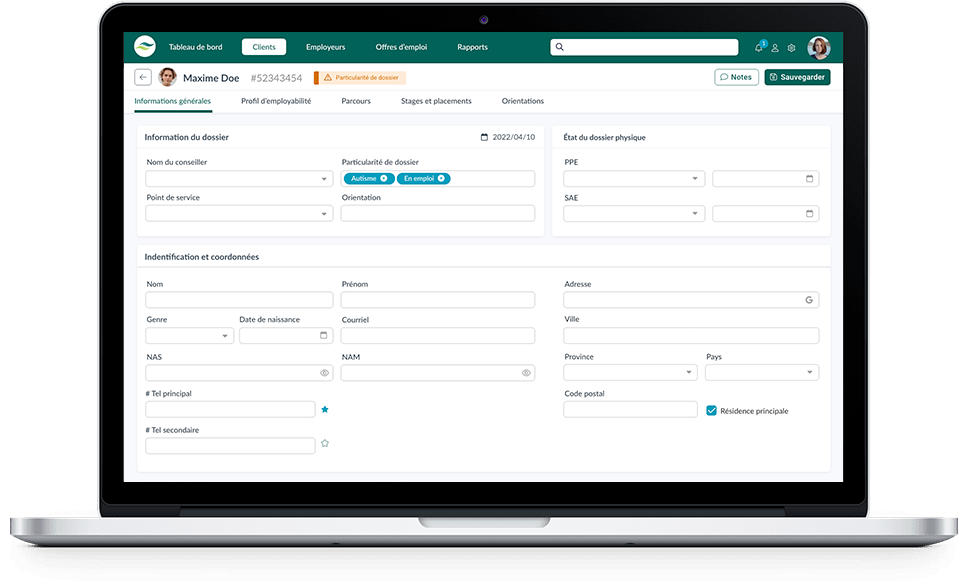SDEM‑SEMOgeneral.label_colon_separator Customized CRM designed to manage thousands of clients.


CRM tailored
for thousands
of clients
The Project
The SDEM‑DEMO offers employment and personnel placement services to help people living with physical or mental disabilities. The team was tasked with managing client and potential candidate files with software that had become obsolete, inefficient and difficult to evolve. The need for a more adaptable tool, one better equipped to handle operations and reduce errors caused by faulty user experience, became pressing. Exolnet was there with the tech solution.
Our Solution
We built a cloud-based platform that enables placement advisors to manage client dossiers in a single web interface. The platform gives them access to the relevant data and online curriculum vitae of potential candidates, making it easier to match their professional skills with companies that have compatible positions or internships available. After placing a client with an organization, advisors can then use the platform to schedule follow-ups and accompany clients throughout their placement journey. We also completely redesigned the information architecture and interfaces to optimize the data collection process and reduce human error.
Rethinking the process
In order to thoroughly re-engineer the existing processes, we spoke at length with those most critically placed to flag issues with the previous application: the placement advisors who regularly update information and follow clients placed with employers. This first step allowed us to identify numerous friction points and potential improvements for the new version of the software. It also helped us target specific weaknesses that were leading to errors or causing significant losses of time.
How does it work?
An efficient client management tool designed specifically for the SDEM‑DEMO
One of the main functions of this CRM is the creation and management of client files. This vast database includes personal information for each candidate (such as physical and mental condition, interests, strengths and weaknesses, etc.) as well as their professional background. With the right data at their fingertips, SDEM‑SEMO advisors can easily match compatible profiles with companies seeking to hire a candidate living with a disability.
To further facilitate the work of the advisors, all data forms were built and adapted according to highly complex business rules.
Inviting dashboard and tools that improve the day-to-day
Another improved feature of the new platform is the updated daily activities dashboard, which lets advisors keep a close watch over the various follow-ups needed for their clientele. The platform lets advisors add notes to client files and schedule the candidate and company follow-ups required by the specific business rules of the SDEM‑SEMO (e.g. touching base with a placement after 30 days). The risk of error or missed engagements is vastly decreased, taking the SDEM‑SEMO service offering to the next level.
Excel reports to export data
An additional benefit of the new platform is the ability to create personalized reports and export them in Excel format. According to their mission and social commitment contributions, the SDEM‑SEMO must regularly submit a range of reports to the government, so this improved function allows users with the right security access to easily export the necessary reports and information.
Increased speed
The new platform optimizes the user experience and decreases the risk of error, all while resolving the lag issues of the previous software. The application we created is faster and more powerful, which in turn leads to a significant reduction in lost or wasted time for the employees.
Modernizing the user experience
Before the development of our solution, the team at SDEM‑SEMO was held back by an overly complex and not especially user-friendly interface. That’s why the design aspect of the new platform was a critical part of the mandate, and why we made sure to involve the main users of the system. Their input was integrated throughout the wireframe approval process, right up to the final design.
Migrating data and launching the cloud
One of the most common risks when updating software is the loss of previously acquired data. To avoid this, we created an importation tool to ensure we could securely transfer data to the new platform. We also used the opportunity to increase overall security standards for the application, integrating data encryption and a two-factor authentication system. And lastly, this new and improved management tool was installed with Amazon Web Services (AWS) architecture, making it accessible at all times and simplifying teleworking capability.